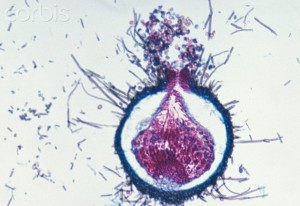Chaetomium globosum is a well known mesophilic member of the Chaetomiaceae family of molds. It is a saprophytic fungus that primarily resides on plants, soil, straw, and dung. Endophytic C. globosum assists in cellulose decomposition of plant cells. They are found in habitats ranging from forest plants to mountain soils across various biomes. Like most Chaetomium species, C. globosum decomposes plant cells using hyphal cellulase activity. Even though they are known to cause soft rot rather than brown rot, C. globosum plant decomposition leaves behind lignin residues. They can decay a variety of wood types such as aspen and pine and even change the colour of paper and books. The cellulase activity of C. globosum functions best at temperatures ranging from 25-32 degrees Celsius and is stimulated by nitrogen and biotin. Cellulase is inhibited by ethyl malonate.
Like many fungal species, C. globosum obtains their energy from carbon sources such as glucose, mannitol and fructose. Fructose is usually digested outside the hyphae using fructokinase activity, whereas glucose enters the cell undigested for cellular metabolism. Even though glucose is the most preferred carbon source, C. globosum mycelium growth occurs at a higher rate when treated with acetate rather than glucose. Carbohydrates can also be stored within the fungus as glycogen and trehalose energy reserves.
Homothallic C.globosum sexual sporulation produces flat lemon-shaped ascospores within clavate ascomata. The appearance of C.globosum fruiting bodies are similar to the pycnidia of the Pyrenochaeta genus. The ascomata optimally fructify at temperatures ranging from 18-20 degrees Celsius and develop asci with 8 ascospores each. Additional conditions such as neutral pH, mild levels of carbon dioxide, the presence of calcium ions, and soluble sugar media also assist in the development of fruiting bodies. The soluble sugar media consists of glucose, maltose, sucrose, and cellulose.
Sporulation preferably occurs in the dark and at high temperatures around 26 degrees Celsius. The presence of cellulose is also crucial for sporulation. The smooth ascospores are initially red in colour, however upon maturation both the fruiting body and ascospores are dematiaceous. Dark perithecia with unbrached radiating hairs can be seen as well. C. globosum perithicia are similar in appearance to the related species of Chaetomium elatum, however the latter is distinguished by its branched perithecial hairs. C. globosum ascospores can withstand temperatures slightly higher than optimal, however temperatures exceeding their thermal death point of 55 degrees Celsius, is lethal for the spores.
C. globosum produce emodins, chrysophanols, chaetoglobosins A, B, C D, E and F, as well as chetomins, and the azaphilones, chaetoviridins. Chetomins induce mammalian and gram positive bacterial toxicity. This allows plants infected with C.globosum to resist bacterial diseases. C. globosum are endophytic to many plants. Their asymptomatic colonization supports plant tolerance to metal toxicity.[20] Heavy metals such as copper, suppress plant growth and disrupt metabolic processes, e.g. photosynthesis. When maize plants were treated with C. globosum, they expressed less growth inhibition and increased biomass. C. globosum is also known to reside in Ginkgo biloba plants. Such plants use this endophytic fungus to suppress bacterial pathogens. In fact, ascospore inoculation reduces bacterial disease symptoms such as wilting, apple scabs, and seed blight in treated plants. Enhancing plant stress tolerance and microbial defense, renders C. globosum application beneficial for agricultural use.





